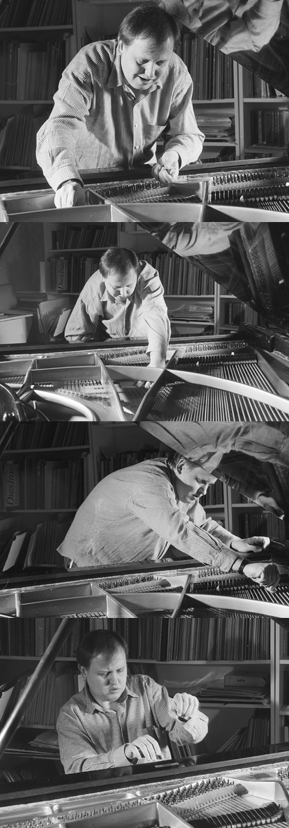As I was six years old, I wanted to learn to play the piano. I could already play the violin to some degree, but it seemed to me rather unsatisfying to play only melody. My father had nothing against my learning the piano. He said it had bothered him all his life that he had not been able to further develop his expertise due to not having the piano as harmony instrument.
So it was urgent to find a teacher. My mother took on this job. But her capacities were very limited, and so over several years it was just a matter of getting to know the piano keys. However well-meaning, she was actually a terrible teacher. Even though I never lost interest in the instrument, I lost all desire to practice.
At any rate, this bungled entry did bring me something: it was a pleasure for me to improvise on the instrument and it helped me, in a playful way, to submit to my wanting to compose music. I can clearly remember having written out a little piece with the dramatic title The Storm. Of course it included lots of chromatic runs over all the keys. Unfortunately I was reading at the same time a biography of Brahms, and was particularly impressed by the self-critical attitude that led to his destroying many of his early works. And so I imitated him, destroying many of my early pieces as soon as I didn’t like them or didn’t like them anymore. Therefore today I can no longer precisely remember if chromaticism was important to me, or just ornamental.
In the meantime my mother wanted me to play Chopin. As my father took me to the director of the Östermalms Musikskole in Stockholm in 1962 my hand and finger positions must have been awful, and I was certainly clumsy and awkward. Walter Wasservogel had been born in Vienna, had to flee the Nazi regime, and wound up staying in Stockholm. He was a well-regarded teacher, but barred from a professorship at the Royal Music Academy in Stockholm, since such positions were at that time reserved for native Swedes. In Sweden one thought that the example of the French Conservatoire had to be followed. Sweden was after all indebted to Graf Bernadotte for the renewal of its monarchy. In 1810, Jean-Baptiste Bernadotte, French Marshal and Napoleonic Duke of Pontecorvo, was adopted by Karl XIII, last king of the House of Holstein-Gottorp. After his death, Bernadotte was crowned as the Swedish king Karl XIV.
So I had the good fortune of having a teacher who in seven months not only provided me with the missing fundamentals of piano technique, but more as well. As an heir of the school of Liszt and of its efforts to broaden conservatory thinking, he also conveyed the fundamentals of an all-around study of music, fundamentals that later showed me the way to the study of composing and conducting. Wasservogel took time for me and was the first to lead me to the works of Bach and Beethoven.
As my family left Stockholm so that I could study music in Vienna, I was not yet aware that the piano would not play the principal role. I was supposed to go through a violin study, with all the rest, including the piano, »on the side«. I was assigned a conscientious (albeit somewhat stuffy) teacher, Maria Brunthaler-Peros, and the subject piano was designated as »obligatory«. She was however sufficiently ambitious to do more than was obliged, and so I played at least once a year as pianist before an audience.
In 1968 I traveled with my father to Finland for a year of guest study, and my piano playing received a new impulse. The Japanese piano virtuoso Izumi Tateno taught at the Sibelius Academy and took me under his wings. In a very short time I was able to play the Scherzos of Chopin and some difficult Beethoven sonatas. Tateno also introduced me to the piano works of Jean Sibelius.
Since then I repeatedly appear as pianist, sometimes also as piano accompanist. The piano is for me also an instrument that facilitates the study of conducting scores and helps me to check my compositions. While the violin has enabled me to make a secure living, it is however the piano that became essential at decisive turning points in my life and during decisive transformations of my style. As I began to occupy myself with interval structures and moved from Vienna to Geneva, I wrote Structures op. 7/II. As I began to examine tempo relations—at the same time that I was hired by the Vienna State Opera—the Bagatelles on the name of György Ligeti op. 14/3a appeared. Every time that it comes to incisive changes, I need the piano: it helps me to further develop and master the driving forces of harmony.
In my life, violin and piano complement one another in an ideal manner. There are areas that the piano cannot take on, and there are areas that the violin cannot reach. They are two completely different instruments, capable of conveying completely different things.
Audio sample:
Sitzchen auf den Namen Ernst Krenek
|
René Staar - Sitzchen auf den Namen Ernst Krenek |
|
Recorded: May 3, 2006 (Schönberg-Haus Mödling)



